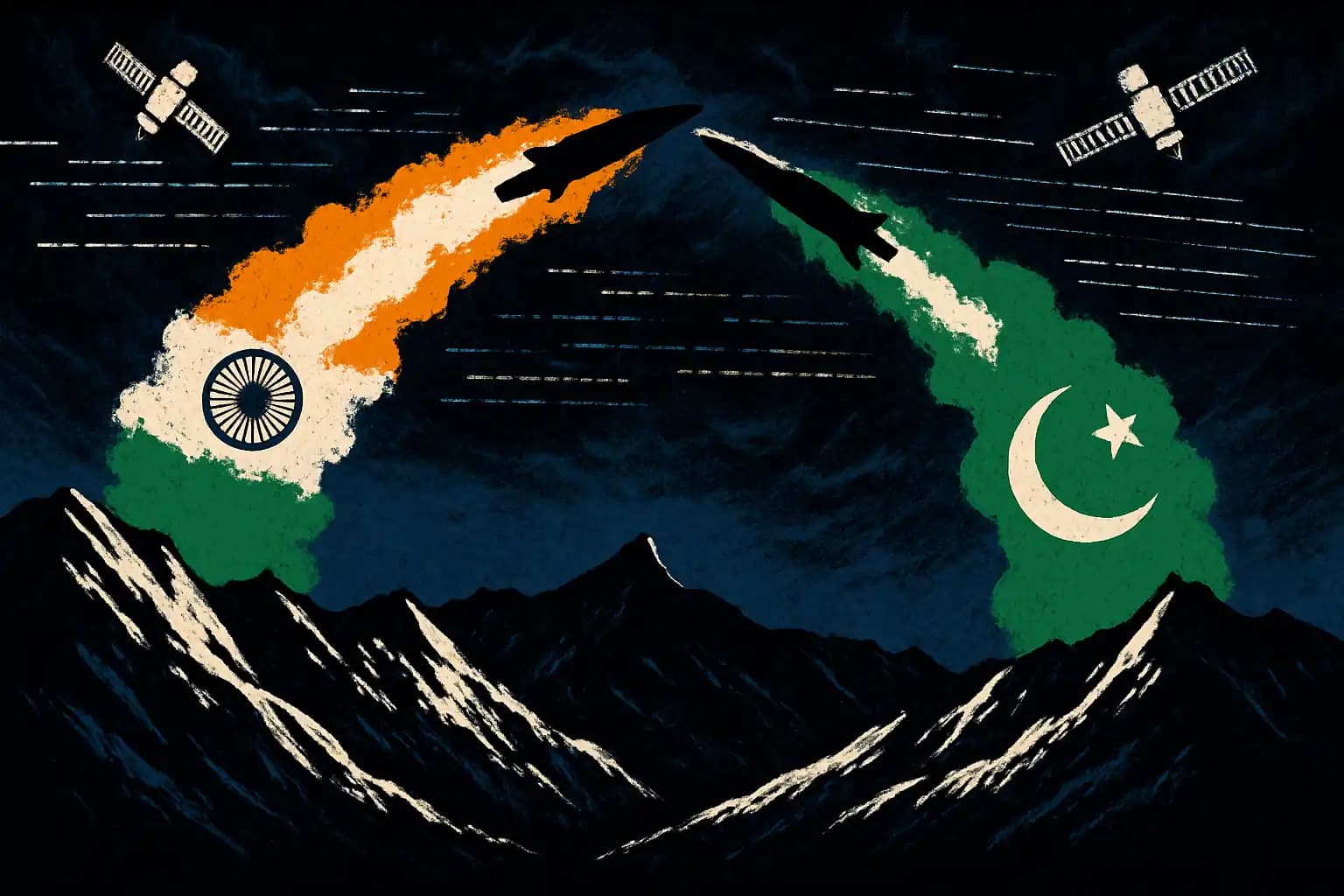The first missile streaked over the Line of Control at 03:17 local time. A midnight trucker, filming a meteor, captured its contrail. Minutes later, explosions lit the hills outside Muzaffarabad and a mosque courtyard in Bahawalpur. This violence killed one child and wounded two civilians. Before dawn, India confirmed “precision strikes on terrorist infrastructure.” Pakistan’s military spokesman broke standard radio silence, promising a “calibrated but crushing reply.” Phones in Washington, Beijing, and Riyadh buzzed—South Asia’s flashpoint was aflame again.
The tit-for-tat feels eerily familiar. In 2019, Balakot; last year, a missile misfire rocked diplomacy. This time, escalation arrives amid geopolitical instability, haunted by AI-driven disinformation in new tech risk briefs and global crises chronicled in doomsday-clock updates. Record-breaking heat waves add stress, risking ignition from any spark.
Rapid Escalation: Inside the Cross-Border Missile Strike
According to the BBC’s initial field report, at least three missiles launched near India’s Gurdaspur district. They crossed the frontier in under two minutes. One landed near Neelum Valley, a spot where militants infiltrate, surrounded by farming villages. Indian officials cited “actionable intelligence” linking the sites to the Kashmiri group Lashkar-e-Taiba.
Pakistani radar logs leaked to media suggest projectiles flew low, hugging the terrain to dodge early warning. This technique matches India’s Nirbhay cruise missile profile from earlier tests. By midday, Islamabad protested at the UN and scrambled JF-17 fighters along the frontier—echoing the 2022 incident chronicled here. Meanwhile, Reuters streamed rolling updates that spiked global oil prices by 4% in one hour.
Strategic Motives: Kashmir Calculus and Domestic Pressures
India’s ruling coalition faces elections in six months, resembling 2019 when Balakot strikes fueled nationalism. New Delhi’s security doctrine emphasizes “pre-emptive hot pursuit,” arguing sub-kiloton terror risks outweigh diplomatic fines. After last month’s Pahalgam bus ambush that killed thirty tourists, the public demanded retaliation. The think-tank Rashtriya Forum projected a 12-point polling boost for a “strong response.”
Pakistan, grappling with 38% inflation and IMF deadlines, cannot appear weak. Its army, the guardian of national identity since Partition, views Kashmir as vital. This dynamic feeds the conflict-trap seen in earlier scenario planning. Each side believes calibrated violence deters larger wars; history shows it often invites them.
This psychology mirrors geopolitical brinksmanship analyzed in Pacific theater analyses: domestic legitimacy, not just border security, drives missile trajectories.
Retaliation Risk: Nuclear Thresholds and International Pressure
Both nations have roughly 160 nuclear warheads, yet their doctrines diverge. India commits to “no-first-use,” though scholars debate the caveats. Pakistan lacks such restraint, reserving nuclear responses to conventional invasions—a stance looming behind every skirmish. The current exchange sits below the nuclear threshold, but escalation risks remain. In 2019, Pakistan’s air raid downed an Indian MiG-21, only international coaxing freed the pilot. This pattern exemplifies “deterrence instability,” detailed on the India–Pakistan relations page.
Washington urged “maximum restraint,” while Beijing offered shuttle diplomacy to protect its Belt and Road assets in Pakistan. Gulf capitals, concerned about remittances, joined the call for calm. However, the global system struggling to manage AI bio-risks, profiled in tech armageddon forecasts, may lack the tools needed to separate nuclear rivals once blood spills.
Information Warfare: Drones, Deepfakes, and the Battle for Narrative
Minutes after the first blast, Indian micro-bloggers posted unverified drone footage claiming destroyed launch pads. Pakistani influencers retaliated with images of bleeding children, accusing India of genocide. Analysts at the Digital Forensic Lab found synthetic artifacts in several viral clips, Hallmarks of generative-AI manipulation similar to tactics examined in media-war investigations.
Drones patrol the skies now. Both armies use Israeli-built Herons and Chinese Wing Loongs for real-time artillery spotting. In a region where peaks block radar, quad-copters extend sight but lower trigger thresholds. Automated target identification, powered by language-model offshoots, can classify a truck as hostile in seconds, echoing autonomy concerns in orbital-defense debates.
Economic Shockwaves: Grains, Markets, and Supply Chains on Edge
South Asia feeds 1.8 billion people. Punjab’s wheat belts, both Indian and Pakistani, stand within artillery range of current flashpoints. Any prolonged exchange threatens harvest logistics, already stressed by heat records in climate-impact dossiers. Futures traders flagged “Kashmir risk” surcharges on basmati exports within hours.
S&P Global raised shipping-insurance rates through Karachi Port by 6%. Meanwhile, telecom firms rerouted undersea cable traffic to avoid Karachi’s landing stations, recalling critical infrastructure vulnerabilities exposed in energy-grid analyses. Contagion moves faster than diplomats.
Diplomatic Off-Ramps: Can the World Pull Two Nuclear States Back?
Track-II negotiators suggest a “zero-hour pause”—a 48-hour stand-down verified by satellite IR imaging—to allow each side to claim de-escalation. Similar pauses helped end the Kargil War in 1999. The United Nations Security Council scheduled an emergency midnight session, but veto politics loom. Saudi Arabia and the UAE, significant investors in both economies, may offer joint economic zones as a bargaining tool.
Yet public anger complicates political calculus. In New Delhi, opposition leaders cheer strikes while demanding tougher stances; in Islamabad, rallies call for honor at any cost. Those voices must compete with algorithms designed for outrage—the same dynamic that fueled the information spiral surrounding magnetic-field scare stories. Whether cooler heads prevail may depend on which side wins the next news cycle, not the next battlefield engagement.
Conclusion: A Familiar Cliff Edge—But Higher Than Before
Missiles crossing the India-Pakistan frontier no longer shock the world; this complacency is a danger. Each new exchange erodes diplomatic muscle memory and normalizes the unimaginable. With hypersonic prototypes, autonomous drones, and AI-driven targeting, the climb from conventional skirmishes to nuclear showdowns compresses. As one analyst quipped, the subcontinent now holds a loaded gun in a hall of mirrors.
The next 48 hours will test whether regional leaders can holster that weapon or whether grievance, politics, and technology conspire to pull the trigger. For a planet grappling with climate upheavals, AI dilemmas, and space-based threats, another war between nuclear neighbors would count as one crisis too many. Transparency portals like Unexplained.co will track every troop-movement pixel; the rest of us can only hope decision-makers read more than their own headlines.





